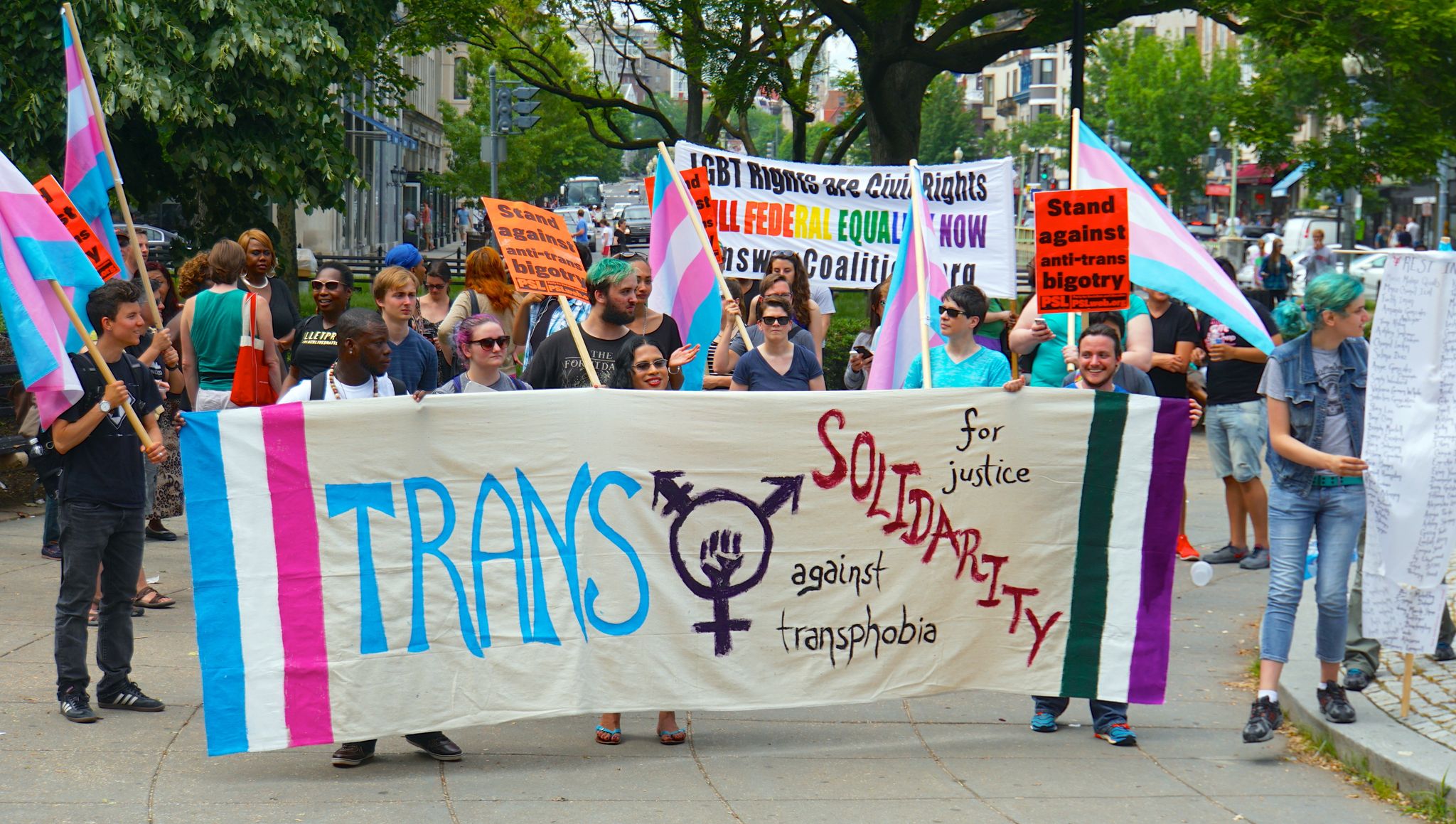It’s the latest fight in LGBTQ battlegrounds across the world: transgender rights. From Caitlyn Jenner’s gender transitioning to the battle over bathroom access, transgender news is flooding the mainstream. And while being transgender is as old as the human race itself, for many people, the topic is new.
How does someone transition from one gender to another? What are transgender people, and what do they look like? For the uninitiated, here’s your primer on being transgender and being a good transgender ally.
What is gender identity?
Gender identity is the innate, internal understanding that one has of their own gender. It’s the subconscious realization that one is a man, a woman, or doesn’t fit neatly into either of those categories.
Traditionally, Americans have treated sex and gender as interchangeable terms, but they do not describe the same things. Whereas “gender” refers to how one perceives themselves, “sex” describes the physical build of a person’s body. A transgender person’s gender does not align with their assigned sex at birth.
The question of “what exactly informs gender?” has been debated for decades. In the 1960s and ’70s, second-wave feminists argued that gender was purely a sociological construct, and gender itself was created to stifle women. Gender theorists have since revised their beliefs, with many arguing that gender is a basic psychological phenomenon that exists beyond sociocultural conceptions. Gender roles only reinforce social or cultural values onto people who already identify with a specific gender.
Gender is, instead, a very real experience. As Scientific American points out, a transgender man’s and a cisgender man’s brain structures mirror each other in important ways, and the same goes for trangender women and cisgender women. National Geographic also reported that sexual differentiation of the brain happens independently of sex’s creation, meaning that a fetus’ psychology and sex aren’t necessarily in sync with each other. So while gender is independent of sex, it isn’t simply a construct.
What does transgender mean?
GLAAD defines “transgender” as an “umbrella term for people whose gender identity and/or gender expression differs from what is typically associated with the sex they were assigned at birth.”
Being transgender has nothing to do with sexual orientation. Just like a cisgender woman (a woman whose gender identity corresponds with her birth sex), a trans woman who is sexually attracted to only men identifies as straight. A transgender person can identify as gay, lesbian, bisexual, straight, pansexual, etc.
Transgender people have been around since ancient civilizations, from Asia to the Americas, in which they were often referred to as the third gender. Today, there are medical therapies and surgeries that allow transgender people to transition with relative ease. Some transgender people engage in surgeries and hormone therapy regimens. Others choose not to. But for every person, gender transitioning is a deeply personal undertaking that can take years to complete.
What is gender transitioning?
Gender transitioning is the process by which a person transitions from their assigned gender at birth and into the gender presentation that aligns with their gender identity. Gender transitioning varies from person to person, and not every transgender individual transitions the same way.
Most commonly, transgender people change their name, appearance, and pronouns. They may also begin wearing clothes and accessories that match their gender identity. Many transgender people also undergo medical therapies and procedures to transition. This is done to lessen the impact of gender dysphoria, or the incongruence trans people feel between their gender identity and their bodies.
The most common medical treatment transgender people undergo is hormone replacement therapy (HRT). HRT involves replacing sex hormones to match the hormones that align with a transgender person’s gender identity. For transgender women, this usually means feminizing hormones that increase estrogen in the body and decrease testosterone to minimal levels, giving them softer skin, breast tissue, feminine fat distribution, and a psychologically soothing effect that helps combat gender dysphoria.
For transgender men, this usually means masculinizing hormones that increase testosterone in the body and decrease estrogen to minimal levels, giving them coarser skin, body hair, facial hair, added muscle mass, and that same psychologically benefit to fight gender dysphoria.
HRT regimens vary from person to person. For transgender women, the most common methods involve oral injection of estrogen and testosterone-blockers, or estrogen injections alongside testosterone-blockers. For transgender men, most undergo testosterone injections, although some use transdermal methods, such as patches and gels.
Once transgender people begin HRT, they use these medications for life. Many trans people call them essential medications for this reason: If HRT access is cut off, then their bodies may begin producing the suppressed hormones again. While specific medications or doses may be tweaked over the course of a person’s life, transitioning hormones are considered the backbone of many trans people’s lives.
But again, not all trans people need to do these things to be “transgender.” To be transgender is simply identifying and/or expressing that your true gender is not your birth sex.
What is gender confirmation surgery?
“Gender confirmation surgery“—also known as “genital reconstruction surgery” or “gender affirmation surgery”—is a surgical procedure in which a transgender person’s body or genitalia is altered to align with their gender identity.
For transgender women, the surgery commonly involves vaginoplasty to construct a vagina. For transgender men, this may involve phalloplasty, or penis construction. The clitoris’s growth under testosterone means some transgender men also undergo metoidioplasty, a surgery in which the clitoris is further lowered to serve as a penis.
Sex reassignment surgeries vary widely, and many other kinds of surgeries are common among transgender people. Some transgender men undergo “top surgery,” or have their breast tissue removed. Some transgender women receive breast augmentation or facial feminization surgery. While many surgeries exist, not all transgender people go under the knife. Some prefer not to for personal or safety reasons, while others are simply happy to go through life without any changes to their bodies.
READ MORE:
- The financial costs of an uninsured abortion
- The best sites for female erotica
- The dirty, complex, empowering history of the word ‘queer’
What is the gender binary, and what does ‘non-binary’ mean?
The gender binary is the sociocultural belief that there are two genders, “man” and “woman,” and that just those two genders encompass all of humanity. The binary is closely tied to cisgender conceptions of gender, in which persons assigned male at birth are “men,” and persons assigned female at birth are “women.”
However, the binary isn’t necessarily relegated to cisgender people, as many transgender people do fall within the gender binary. For instance, a transgender woman is considered “binary trans,” because she identifies with one pole in the binary: “woman.” And in reality, gender functions like a spectrum, so there are many people who do not identify with being a “man” or a “woman.” Instead, their identity rests outside the binary: either somewhere on the gender spectrum between both poles, or irrelevant of it altogether. This is called being “non-binary.”
Non-binary itself is an umbrella, and many gender identities exist inside of it, such as genderfluid, genderqueer, bigender, or agender. Some non-binary people identify with the trans umbrella, and others don’t. But seeing as non-conforming gender identities receive significant acceptance and support under trans rights causes, non-binary and trans rights are often tied closely together.

How can I be a better ally to transgender people?
Being a good ally can be tough. While transgender rights are closely tied to the rest of the LGBTQ spectrum, trans people are traditionally stigmatized both inside and outside of the community. This means that allies need to work extra hard to raise and support the voices of their trans peers.
For one, unconditional acceptance is the best way to show care and support to a trans person. Accept them and their gender identity on their terms. Avoid asking intrusive or invasive questions about their gender transitioning or sexuality. It’s considered highly invasive to randomly ask a trans friend about their transitioning process, so don’t talk about it unless they open up.
Most of all, many trans people struggle with limited medical access or are otherwise relegated to low socioeconomic status due to employment discrimination. Extending an extra hand—whether by giving them a ride to the doctor’s, helping them pay the bills, going to a support group meeting with a trans friend, or serving as a shoulder to cry on if they need emotional support—goes a long way for many trans people.
Where can I learn more about transgender people?
We’re glad you asked! There are many books, documentaries, TV shows, and more available that explore transgender topics. If you’re looking for a thorough 101 overview, we recommend Nicholas Teich’s Transgender 101, while Laura Erickson-Schroth’s Trans Bodies, Trans Selves is also an excellent source for in-depth discussions about everything from gender dysphoria to trans sexuality. Imogen Binnie’s novel Nevada also features a solid look at the lives and experiences of transgender women living in the 21st century, and Jazz Jennings’ show I Am Jazz takes a look at the successes and struggles of transgender teens living in the United States.
And if you’d like to learn more about transgender current events, check out the Daily Dot’s coverage, including up-to-date stories about trans rights across the U.S. and the world at large.



